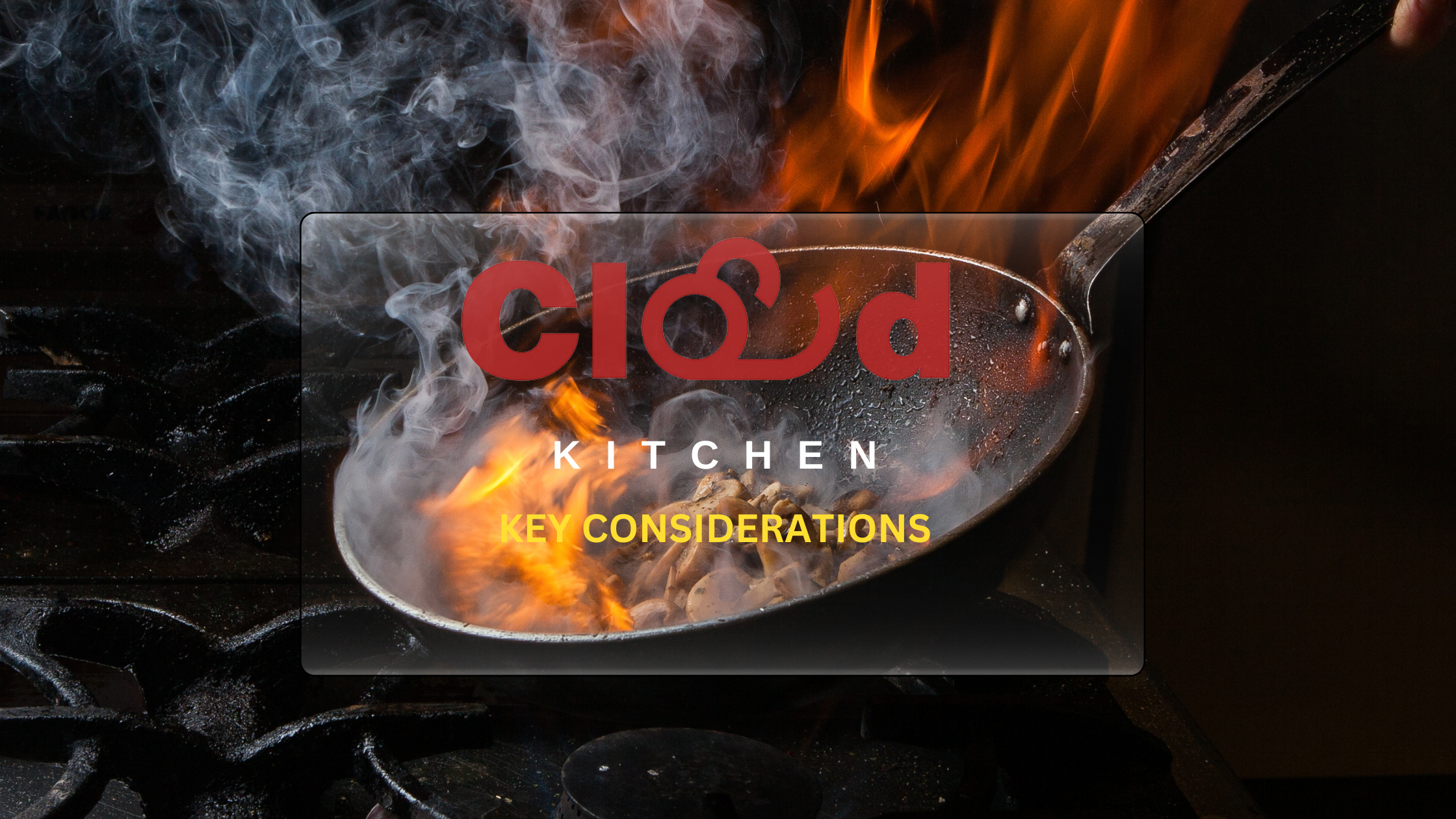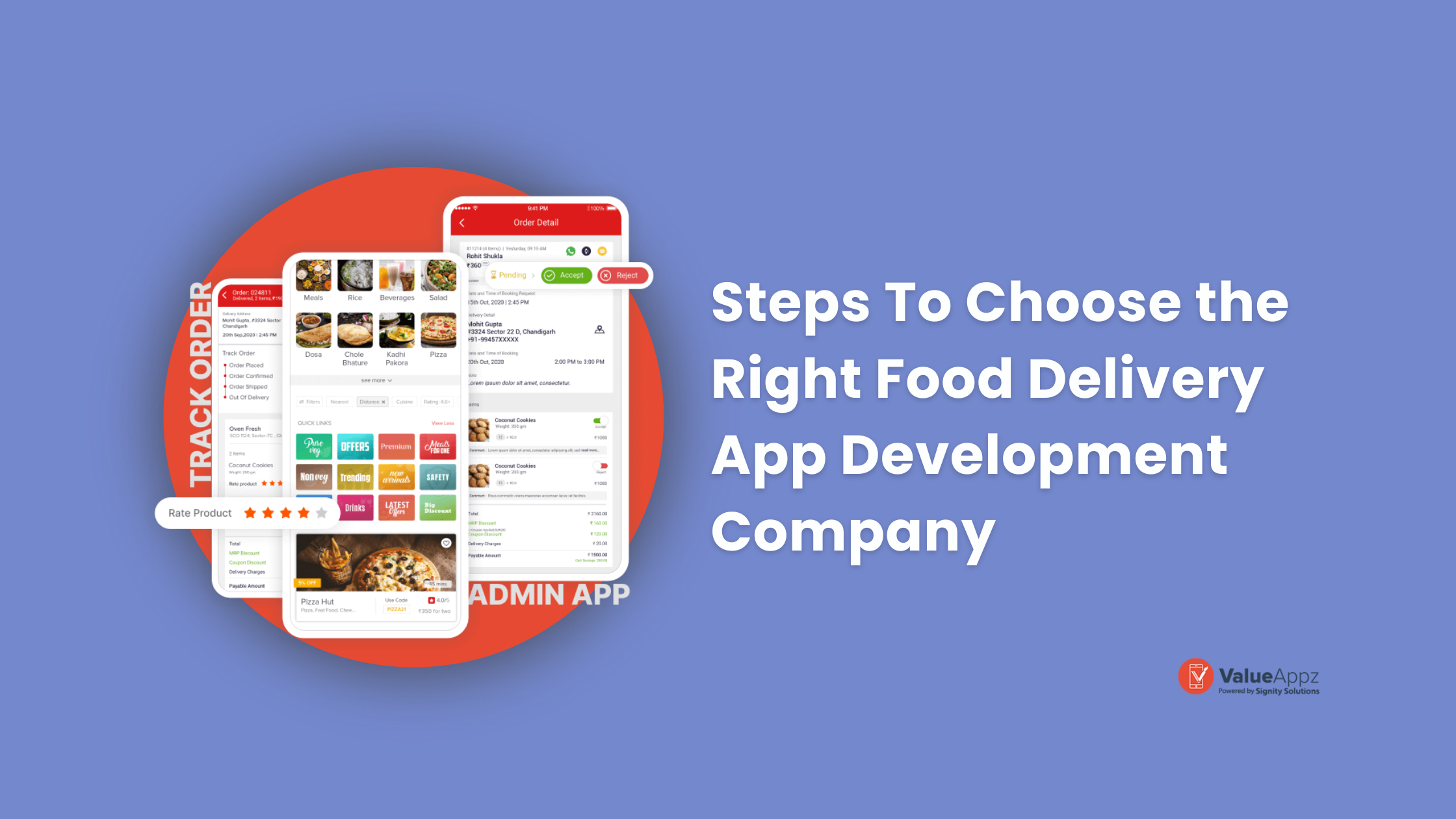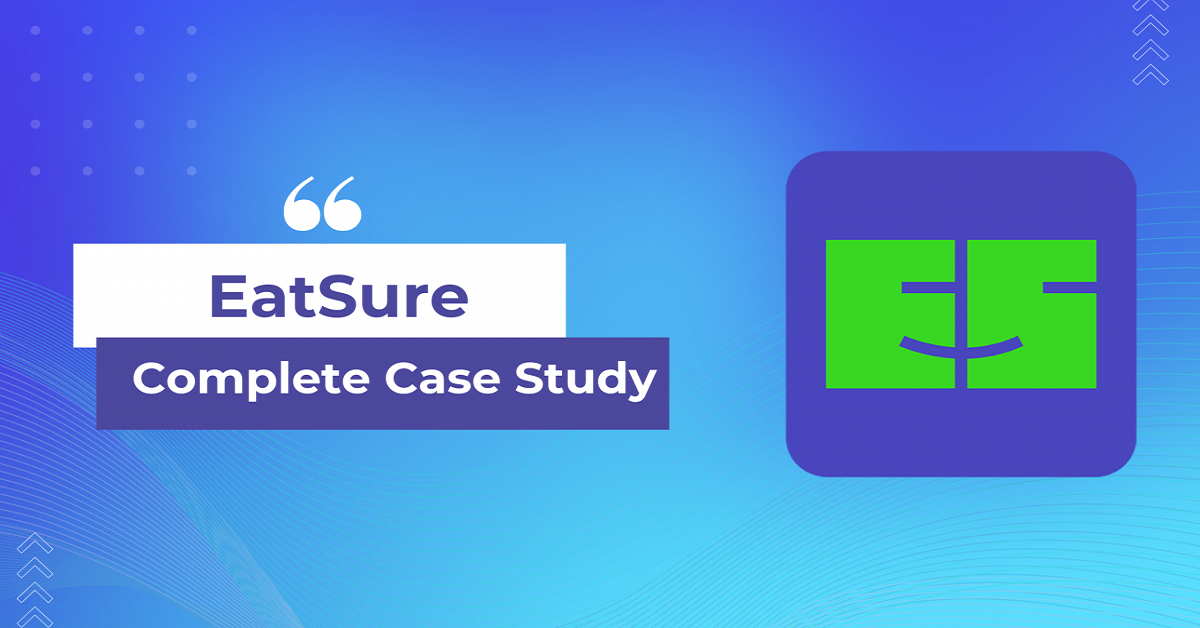How To Develop A Food Delivery App: Step-by-Step Process Explained
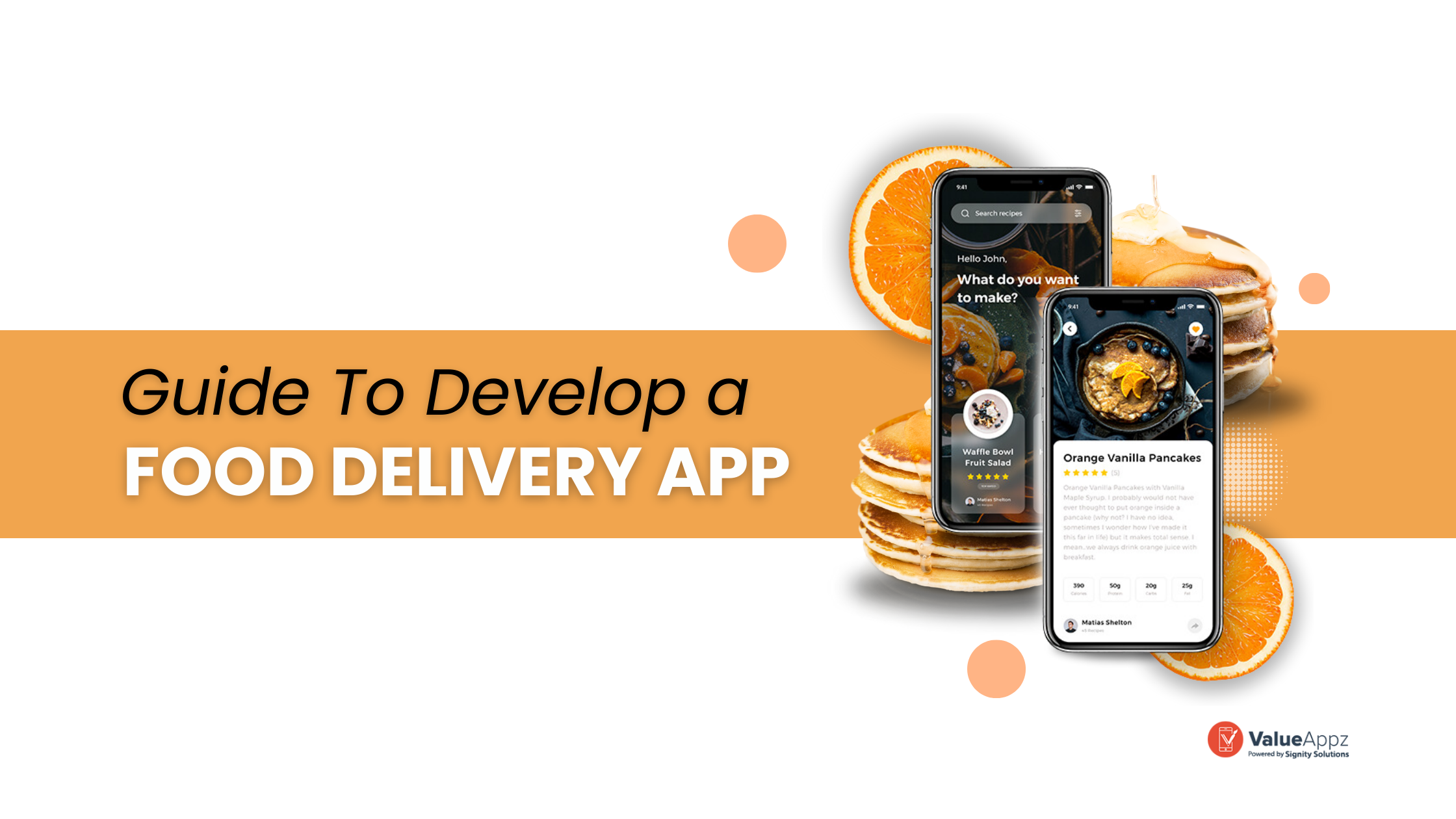
Quick Summary: Are you thinking about developing a food delivery app and competing with your rivalries? Building a food delivery app can be hectic, but not if you follow the right process. Discover how you can create your app step-by-step, from research to app launch, with our guide.
Are you looking to create an on demand food delivery app to compete with industry giants like Uber Eats and Zomato? Or you own a food delivery business and want to take it online to reach a wider audience. Either way, with the increasing demand for online food delivery services, launching a food delivery app can be a profitable venture.
But how do you ensure your app fills the market gap and engages your target audience? In this blog, we’ll take you through the step-by-step process for building a solid food delivery app that provides the right solution to your users and engaging app features, ensuring a seamless experience through expert food delivery app development services.
Keep scrolling to check the complete steps in developing a feature-rich on demand food delivery platform.
Table of Contents
Steps-by-step Process to Develop A Food Delivery App
There is massive competition in the on demand food delivery industry, so how to develop a food delivery app that engages the target audience? Below is the complete process to create a food delivery app.
Step 1: Do A Complete Market Research
When creating a food delivery app, market research is the first step. To build a successful app, it will assist you in recognizing the competition, understanding customer expectations, and making wise selections.
Further, market research will help analyze the competition. You can evaluate their features, user experience, pricing strategies, and customer reviews to understand if there is still any gap in meeting the customers’ demands.

On demand food delivery apps are not a decade-old concept; instead, the first online food ordering service started in 1995, known as Worldwide Waiter (now known as waiter.com). Since then, this market has seen an uphill in its growth.
But what makes the best food delivery apps attractive and addictive for users?
The first reason, of course, would be the convenience, but other factors like discounts, unlimited options, easy payments, etc., are also responsible for its growth. Such features have made food apps so addictive that users now mostly prefer ordering food online rather than paying a visit to the restaurant.
The food delivery app industry is projected to reach $320 billion by 2029. Further, 60% of restaurant owners believe that offering food delivery has added great sales to their business.
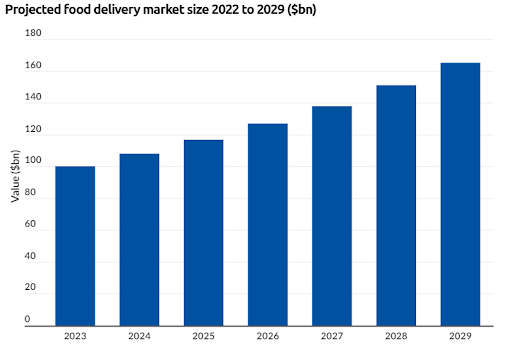
Source: Business of Apps
Step 2: Pick A Business Model

The next crucial stage in the process of developing a food delivery app is picking the appropriate business model. Consider alternatives like an aggregator strategy, in which you collaborate with numerous restaurants and provide a wide selection of options, or a logistics-focused approach, in which you concentrate on delivery services for restaurants without their own drivers.
Another choice is a fully integrated approach, where you partner with cloud kitchens or offer delivery services in addition to having your own kitchen. To ensure the success and sustainability of your food delivery app, the business model you choose should be compatible with your target market, competitive landscape, available resources, and overall value proposition.
As a startup, you must know that there are majorly two types of food delivery apps:
2. (a) Restaurant-to-Consumer Delivery
Such a model is used by restaurants that provide a digital version of their restaurants. It aims to provide food to consumers from a particular restaurant through their application.
One of the best examples of this is Domino’s. Though Domino’s is available on other platforms like UberEats and more, it also has its own food delivery app, where customers can directly place an order and receive it straight from Domino’s (hence, not including any third party).
2. (b) Aggregator Model
The Aggregator model has already acquired the food delivery market by providing services at consumers’ convenience. Platform-to-consumer delivery apps bring multiple local restaurants on one platform, where they can place their menus, discounts, and offers. Furthermore, the users can search for restaurants, place orders, and get them delivered quickly.
The best examples of food delivery services are Uber Eats, DoorDash, and Grubhub, which have millions of users on their respective applications. The aggregator model gives a variety of options to choose from, making it lovable among the audience.
👋 Are you feeling lost and unsure about which business model to choose for your food delivery app startup? Don’t worry. We’re here to help! Contact us today for a free consultation.
Step 3: Consider the App Development Cost
As a startup or any other business, cost is an essential factor. You need to ensure that it aligns with your budget.
Estimating the exact amount for food delivery apps can be difficult as it can only be decided after considering factors like the complexity of the app, maintenance, app platform, software and technology required, and the team you will hire to develop the app.
The average food delivery app development cost can range between $15,000 to $60,000. But this can further vary depending on the factors mentioned above. Hence, choosing the right company that fits your budget requirements is extremely important.
But why does the cost vary so much? And what other factors affect the development cost? The answer is app features. To build a competitive food delivery app, you need basic and advanced features for all four apps—customer, service provider, admin, and delivery agents.
Below are all the must-have features for your food delivery app.
Step 4: Choose the App Features
Essential features to consider are a user-friendly interface for simple ordering and tracking, a thorough restaurant listing with search and filter options, secure payment options, real-time order tracking, restaurant reviews and ratings, customer support, loyalty programs, and push notifications to keep users interested.
Furthermore, considering features like social media integration, tailored suggestions, and in-app chat can improve user experience and set your app apart in the competitive food delivery industry.
Here are all the features you should include in the customer, restaurant, admin, and delivery app.
4. (a) User App Features
Once your app comes into the market to the point where it gets valuable customers, engaging and retaining them is vital. The following features can help with it.
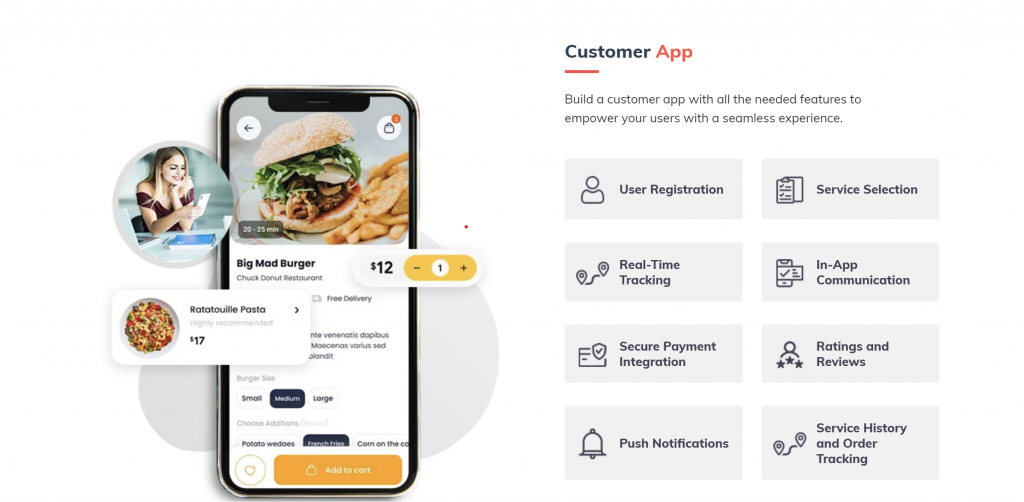
Source: ValueAppz
Easy User Registration
Registration is the first step that users will take. So, it should be simple and quick. It can be either done through email and password or via social media like Google, Twitter, Instagram, and more. Whatever the app contains, the data should be protected, so the user has a sense of security.
User Profile
Now that the users have registered, they would want to manage their profiles. Their profile will include personal information, favorite restaurants, order history, saved payment options, food preferences, and much more that can provide quick access to them.
Geolocation
Setting the exact location should be simplified. It can be done via auto-detecting or filling in the details manually. The location can be further categorized into the home, work, or other categories.
Their exact location will also help users to find nearby restaurants. Additionally, it will also connect the users with local restaurants.
Restaurant/Dish Search
Search option directly affects user retention. The easier users find a restaurant or dish, the better the chances they will return. To make the feature more user-friendly, you can add certain filters like location, food category, etc.
They should be able to locate multiple restaurants quickly.
Placing an Order
Making an order should be totally easy for the user. They should be able to add items to the cart, remove items, or add more if needed. The total cost, including the delivery fee, should also be available in the cart with other information regarding tax, service fees, and more. Further, a feature like pre-order food will be a cherry on top of the cake.
Quick Payment
Now that the user has placed an order, making payment should not be a problem. They must get multiple payment options like debit or credit card, cash on delivery, UPI, or through other in-built payment methods.
Real-Time Tracking
Real tracking of the order allows users to get instant updates on their food, whether it is in the preparation stage, packing stage, or prepared food is on its way, and estimated delivery time so that they can monitor it throughout.
Further, information regarding the delivery driver allows them to contact the person directly.
Customizing Orders
People have become conscious about what they eat. A customization option in the application will help in user retention. Restaurants and food delivery providers must adjust to the users’ options. For instance, some may be allergic to a food item, or others may want gluten-free food.
In-App Messaging
The feature is crucial as it will allow users to contact customer care in case of any problem. An in-app messaging feature will also help them communicate with couriers.
Rating and Reviews
Consumer feedback is an essential part of the app. They should be able to rate both the food and the delivery. It provides them a space to share positive and negative experiences with others. Also, the admin can use this to enhance their app.
Push Notifications
Through push notifications, users can get information regarding discounts, coupons, special offers, and estimated delivery time, ensuring they get critical data. It is also used to provide every-minute details on their current order.
4. (b) Restaurant App Features
Restaurants are another part of this three-sided business model. Hence, each restaurant should be able to display menus, provide information, and quickly get in touch with its customers. Its features should include the following:
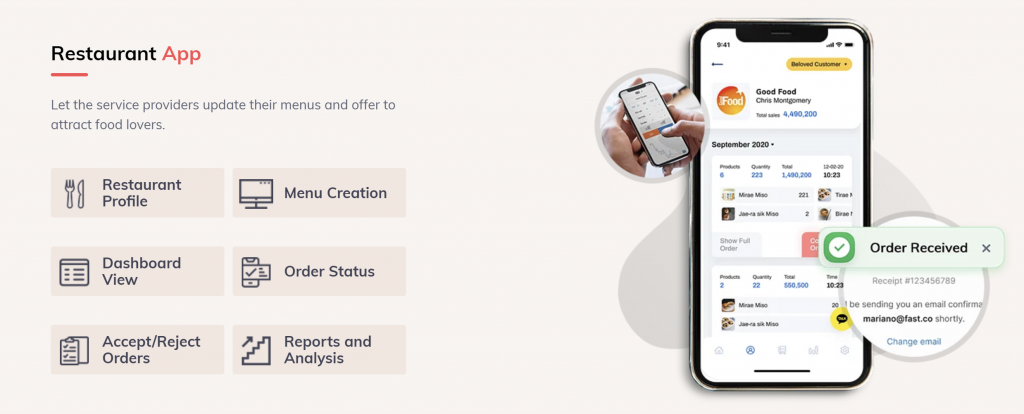
Source: ValueAppz
Dashboard
It is the primary feature, ensuring access to multiple management tools like controlling delivery orders, public data, and other content.
Registration
This feature will help a restaurant create a representative account that will be displayed on the search. Restaurants usually undergo authorization with login (company name) and password.
Content Management
Content management features will let the restaurant edit public information like restaurant name, working hours, address, dish prices, delivery rates, menu, photos, videos, and much more.
Order Management
This function will help restaurants track the order in real time. It can contain information about order status, whether it’s accepted, ready, delayed, or canceled.
Receiving Payments
As restaurants receive the payment after placing the order, a payment feature is essential for a transaction fairness guarantee.
Customer Support
Restaurants should be able to track their customer’s concerns via live chat. They should quickly receive any questions from buyers and answer them instantly.
4. (c) Delivery App Features
Food delivery app development for delivery partners is equally important as they will use it on the go. It must include all features that make food delivery easy and where they can contact in an emergency.
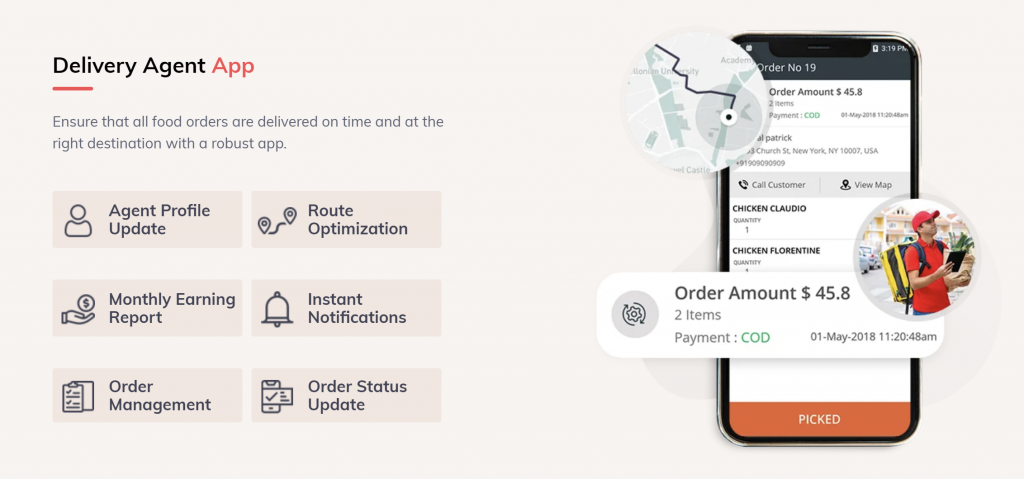
Source: ValueAppz
Registration
As much as customers and restaurants must make a profile, so is it for the delivery people. It can be done by email, password, or social media accounts.
Profile Management
The profile usually contains information about name, working hours, photo, and others. The feature should be easy to use to make any changes hassle-free.
Order Management
Such a feature will help delivery workers to view, accept, or reject delivery orders.
GPS Support
It is imperative to ensure that the driver delivers food to the correct address without the delivery person getting lost in the way.
Contact Restaurant/Customer
The delivery person should be able to contact a consumer or restaurant if needed while delivering food.
4.(d) Admin Panel Features
The admin app gives the admin complete control over the food delivery operations. From managing orders to handling deliveries, restaurants, and more, a robust app can help the admin manage everything seamlessly.
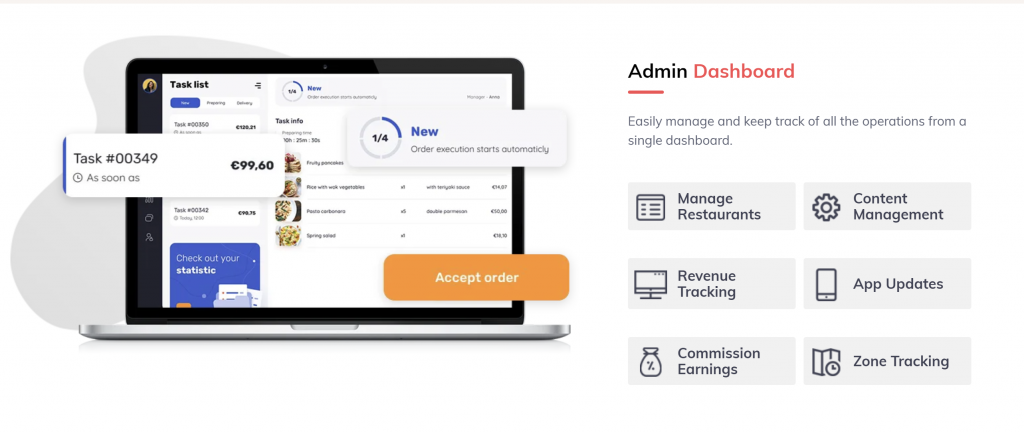
Source: ValueAppz
Admin Dashboard
The dashboard will give the admin a centralized view of key performance indicators like order volume, revenue, customer feedback, and more relevant metrics.
Order Management
This particular feature is essential for the admin to access and manage all incoming orders through one app. It should include viewing order details, tracking status, and updating it timely.
User Management
The admin should also be able to manage user accounts, including customers, delivery drivers, and restaurant partners.
Restaurant Management
The admin app must also give the power to manage restaurant partners through the app by verifying their information, setting commission rates, and assisting with menu setup.
Analytics and Reports
The analytics and reports are another vital feature to include in the admin app. They should be able to access data on order trends, feedback, sales, and more.
Delivery Fleet Management
This feature should let the admin manage and assign deliveries. They should be able to track driver locations, assign or reassign orders, and monitor the delivery progress.
👉 Must read: 15 Essential Food Delivery App Features You Must Include
Step 5: Pick the Revenue Models
You have decided on the business model and features, but how will you make money with your food delivery app? There are several possibilities to think about, like commission-based business models where you deduct a fee from each order handled through the app. Using a subscription-based model, where customers pay a monthly or yearly price for premium features or perks, is an additional strategy.
Alternatively, you may partner with restaurants or other pertinent businesses to add advertising as an income stream. Regardless of the model you select, it’s critical to carefully assess the market, user trends, and competition to establish the best and most efficient revenue strategy for your food delivery service.
Some of the revenue models followed by the leading food delivery apps include:
5.(a) Delivery Fees for Every Order
Earning money through delivery fees is the most popular way among food delivery companies. There can either be a fixed delivery fee or a charge depending on the distance between the restaurant and the customer.
5.(b) Commission from Restaurants for Each Order
It is a stable way to get money. A commission fee can be fixed based on the size and popularity of the restaurant, and you can change it depending on the orders a particular restaurant receives. So, every time the restaurant gets an online order, a specific commission can be charged.
5.(c) Cost for Advertising
Charging for advertising is an effective monetization method. Restaurants would want to enhance their brand recognition on the food delivery apps, and one way that will help them is by creating effective ads. They can be charged a service fee for advertising to increase their chances of engaging more customers.
5.(d) Partnering with Restaurants
Some of the food delivery apps collaborate with restaurants to provide exclusive deals or partnerships. These partnerships include revenue-sharing agreements, where the food delivery app receives a percentage of revenue generated by these collaborations.
Step 6: Choosing the Right App Development Company
When it comes to app development, choosing the right partner is crucial. The development team you select will have a significant impact on the success of your app, both in terms of functionality and user experience.
Here are some things to consider when selecting an app development partner:
1. Experience: Look for a team with a proven track record of successful app development. Experience in your industry or niche can also be a plus.
2. Expertise: Make sure the team has the expertise required to develop your app, including skills in areas such as frontend and backend development, API integration, and database management.
3. Communication: Clear and open communication is essential for a successful partnership. Make sure the team you choose is responsive and able to communicate clearly and effectively.
4. Flexibility: App development can be a complex process, and requirements can change along the way. Look for a team that is flexible and able to adapt to changing needs.
👋Looking for a reliable and experienced food delivery app development company to bring your app idea to life? Look no further! Get in touch with us today to discuss your project requirements and take the first step towards building a successful food delivery app.
Step 7: Designing the App
The layout should be simple to use, sensible, and visually appealing. It should have essential functions, including simple navigation, restaurant and menu item search and filter choices, a quick and secure ordering process, real-time order tracking, and practical payment alternatives.
A well-designed app should also take into account the various user preferences, including adaptable profiles, tailored recommendations, and seamless social networking platform integration for simple sharing and rating of food experiences. A user-centric design strategy can improve the overall user experience and increase your food delivery app’s likelihood of success.
Step 8: Third Party Integrations
It lets the app take advantage of already-existing features and services, improving user experience and optimizing processes. Payment gateways for safe transactions, mapping, and geolocation APIs for precise tracking and delivery, SMS or push notification systems for order updates, and restaurant APIs for gaining access to menus and inventory data are just a few examples of third-party services that can be integrated.
The app can offer seamless and effective interactions between clients, restaurants, and delivery personnel by integrating various services, making it more functional and feature-rich.
Step 9: Testing Beta Version
Testing is a crucial component in the process of developing a food delivery app. In-depth user acceptance testing and quality assurance are used to find and fix any errors, problems, or usability difficulties. A thorough testing process must include the user interface, functionality, performance, security, and compatibility with various hardware and operating systems.
Testing thoroughly allows developers to ensure that the app is stable, safe, and offers the best user experience, ultimately resulting in a successful and dependable food delivery service.
Step 10: App Launch and Marketing
Launching and efficiently marketing a food delivery app is the last phase in the development process. It includes developing a thorough marketing plan incorporating branding, online and offline promotion, social media interaction, and collaborations with nearby eateries. Creating an intuitive app with simple navigation, appealing design, and safe payment methods is also essential.
You may continuously enhance the functionality and user experience of the app by putting in place effective customer service channels and obtaining user feedback. Last but not least, data analytics will help monitor important indicators and make data-driven choices for individualized marketing campaigns and app improvements.
💡 Are you interested in tapping into the lucrative food delivery market? Let us help you generate revenue by launching your own customized platform. For more information, get in touch today.
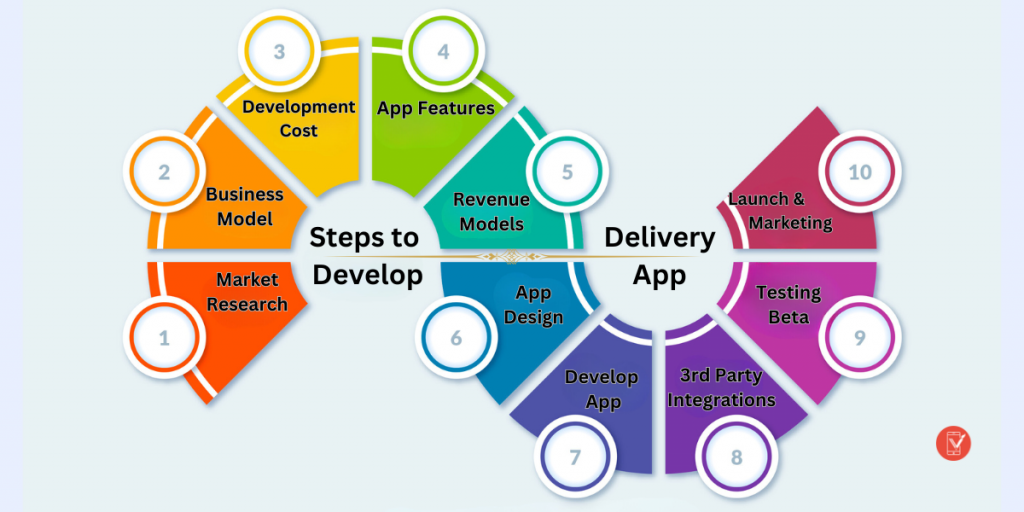
Turn Your Food Delivery App Startup Idea Into Reality with ValueAppz
Are you dreaming of launching your very own food delivery app? We know how overwhelming it can be to find the perfect team to make your idea a reality. But don’t worry, we’ve got you covered!
At ValueAppz, we understand that your app should be unique and tailored to your specific requirements. We have the perfect combination of technology and skills to make that happen. Our team of experts is dedicated to providing top-class on demand food delivery app development services. We will work with you to bring your vision to life.
And if you’re looking for an app like Uber Eats, Zomato, or other popular food delivery services, we also offer clone app services. Contact us today, and let’s make your dream a reality!
Key Takeaways
- The food delivery app industry is continuously growing, and the number of users is expected to grow.
- The steps to create a food delivery app include market research, picking a business model, considering the cost, choosing features and revenue models, designing and developing the app, and testing and launching the app.
- Two major types of food delivery apps are restaurant-owned apps like Pizza Hut and aggregator models like Uber Eats.
- The average cost of building a food delivery app ranges between $15,000 to $60,000.
Frequently Asked Questions
Q1. How Do I Create a Food Delivery App?
Steps to create a food delivery app include:
- Market research
- Choose a business model
- Consider the cost
- Pick the app features
- Decide the revenue models
- Design and develop the app
- Test and launch the app
Q2. How Do I Create an App for My Food Business?
To create an app for your food business, research your target market, identify key features, and hire a skilled food delivery app development company.
Q3. How Much Does it Cost to Make a Food App?
The cost of food delivery app development can range from $15,000 to $60,000. This cost can further vary based on factors like app design, features, development team, etc.
Q4. Which Technology Stack is Suitable for a Food Delivery App?
- Front-end: React Native, Flutter, or native development (iOS: Swift, Android: Kotlin/Java).
- Back-end: Node.js, Ruby on Rails, Django, or Laravel.
- Database: MySQL, PostgreSQL, MongoDB.
- Cloud Storage: AWS, Google Cloud, or Azure.
- Payment Integration: Stripe, PayPal, or other relevant APIs.
Q5. What are the Key Features to Include in a Food Delivery App?
Key features to include in the food delivery app are user registration, menu integration, online payments, push notifications, user support, and real-time order tracking.
THE AUTHOR
Mohit Yadav
As an expert in Digital Marketing, I always look forward to keeping up with the latest trends and customers’ changing demands. Hence, I focus on content that updates the readers in-depth about the industry.

Get ready to digitally transform your business.
Let our team help take your business to the next level. Contact us today to get started on finding the perfect solutions for your business needs.





